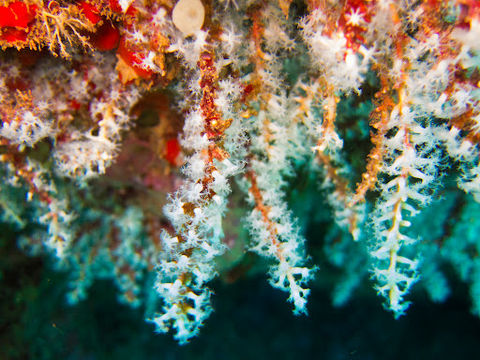Carijoa riisei
Snowflake Coral
Class: Anthozoa
Order: Telestacea
Family: Clavulariidae

Photographer: © Ken-ichi Ueda; Ken-ichi Ueda
Source: http://eol.org/data_objects/21950507
Description
Carijoa riisei is a soft, branching coral that forms carpets by attaching to hard surfaces in marine waters. The cylindrical branches have multiple polyps which have eight white tentacles when extended. Unlike other corals, Carijoa riisei does not have any symbiotic algae and therefore is an obligate predator of zooplankton. Also, Carijoa riisei cannot grow in direct sunlight so this coral flourishes in shaded and deeper waters.
Ecological Threat: This coral is an ecological threat in two ways, by being a voracious predator of zooplankton and growth by carpeting other native corals. With Carijoa riisei consuming high levels of zooplankton it is able to out-compete other native corals and invertebrates that survive off of zooplankton. Studies have shown that Carijoa riisei populations will blanket native Black Coral populations and severely reduced the size of the colonies, especially in deeper waters. By overtaking black corals the snowflake coral is severely changing oceanic ecosystems at depths we can’t properly monitor or manage.
Biology: This coral is in the Cnidaria clade and has a juvenile planula stage which is free-floating and can attach to any hard surface. This life cycle feature allows Carijoa riisei to be spread by boats. The snowflake coral also has a higher fecundity than other corals. The almost continuous reproduction of this coral allows it to “takeover” new habitats. Mature polyps can reproduce asexually or sexually by a release of gametes; the resulting planula larvae settle on the bottom and develop into young polyps.
History: The snowflake coral was first described off of the US Virgin Islands in 1860 as Clavularia riisei and was thought to be a native coral of the Western Atlantic. Later in 1972, it was discovered in Hawaii at Pearl Harbor. By thinking that Carijoa riisei is a native to the Western Atlantic the invasive coral has been established along Florida’s coastline and the Gulf of Mexico for an unknown amount of time. However, the earliest date for the Florida Keys is 1936.
It wasn’t until 2010 when a phylogenetic survey was performed by collecting specimens of Carijoa riisei off of the coast of each continent (except Europe) and comparing them, that is was realized the snowflake coral is not a native of the Western Atlantic. The study demonstrated that Carijoa riisei is more closely related to species in the Indo-Pacific than those in the Western Atlantic. This suggests that the population in Florida, Puerto Rico and Brazil are actually the invasive populations. However, with an undocumented presence of Carijoa riisei in Hawaii the snowflake coral is, and should be considered as, an invasive species.
U.S. Habitat: marine and estuarine habitats and coastland. Known to grow will in turbid waters rich in organic material and requires a firm surface for attachment. Carijoa riisei
Distribution
Native Origin: Indo-Pacific oceans
U.S. Present: FL, HI, and PR, also found in the Gulf of Mexico
Management
In the native Indo-Pacific region there are two species of nudibranchs that feed on Carijoa riisei one being, Tritoniopsis elegans, which is a generalist feeder and does not specifically eat only Snowflake coral. Yet, the other nudibranch Pyllodesmium poindimiei feeds exclusively on Carijoa riisei and will even starve in the absence of the snowflake coral. Unfortunately, these nudibranchs are endemic to the Indo-Pacific waters and can only help Carijoa riisei infestation in Hawaii; because introducing these nudibranchs to the Caribbean waters could cause unforeseen damage.
Unfortunately, this coral is still actively sold online and offline for the aquarium trade and the souvenir trade. So until it is found illegal to sell Carijoa riisei, this coral will continue to spread in to Atlantic waters and the Gulf of Mexico.
Text References
Concepcion, G. T., Kahng, S. E., Crepeau, M. W., Franklin, E. C., Coles, S. L., & Toonen, R. J. 2010. Resolving natural ranges and marine invasions in a globally distributed octocoral (genus Carijoa). Mar Ecol Prog Ser, 401:113-127.
Grigg RW. 1965. Ecological studies of black coral in Hawaii. Pac Sci 19:244–260.
Internet Sources
http://www.hawaiiinvasivespecies.org/
http://www2.bishopmuseum.org/HBS/invertguide/
 Texas Invasive Species Institute
Texas Invasive Species Institute